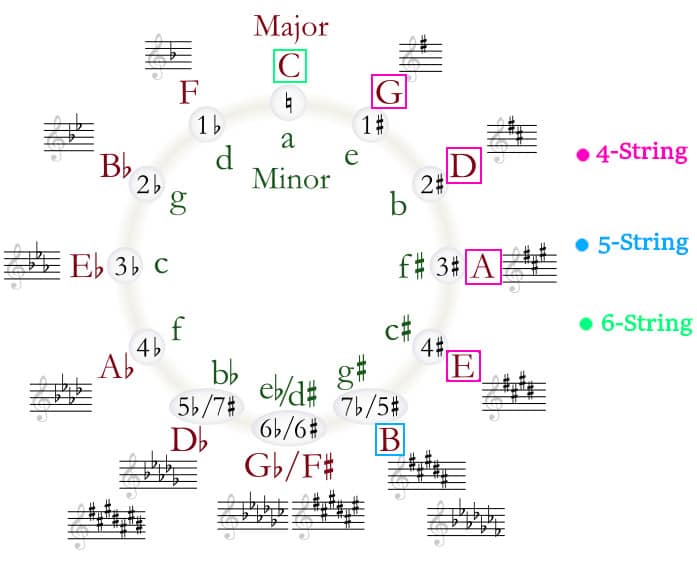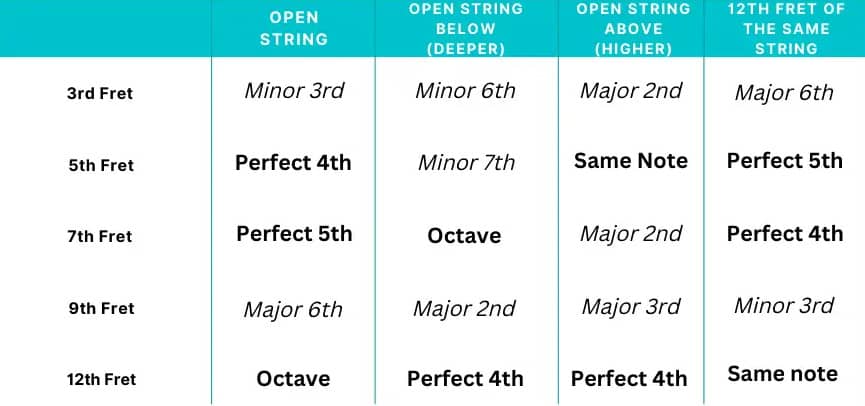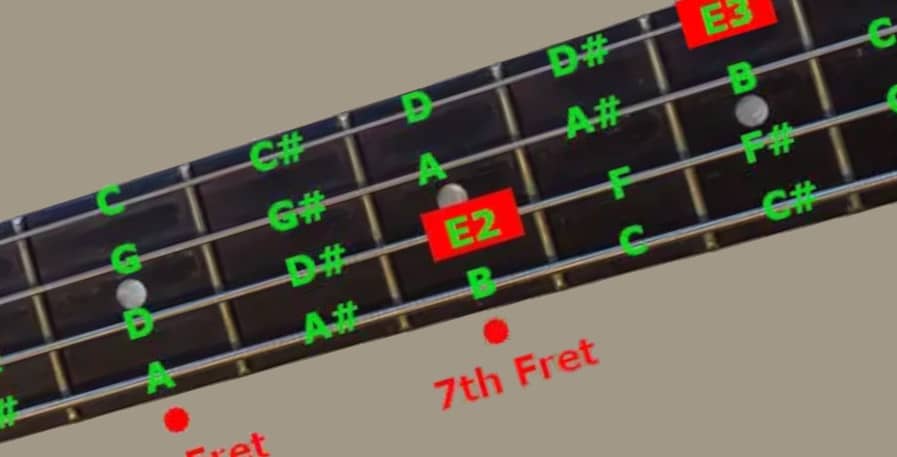There are 88 notes on a 4-string bass with 21 frets. However, memorizing each one of them is both tedious and unnecessary. In my experience, it is much preferable to memorize a handful of key notes and work your way out from there.
That`s why I`ve made this guide on what I consider to be the 5 most important notes on the bass guitar.
I will teach you how to easily find these at different spots on the fretboard. You will also learn how the notes relate to one another, and how this relationship is what makes them key notes in the first place.
Some aspects of what makes these bass notes in particular key notes can only be explained by using music theory. However, you will still learn where to find these notes and what makes them important even if you have zero theoretical experience.
I`ve also skipped talking about notes above the 12th fret. This is because they are less commonly used in bass lines. Thus, avoiding them altogether made for a more easy-to-read article.
Key note 1: E
The most important note on your bass guitar is “E”. This is the note that rings out when you play the thickest string on a 4-string bass, which is why we call it the E-string.
“E” is also the most important note on the 6-string guitar. As a result, a lot of songs are written in the key of E. This means that a lot of the songs you will learn on the bass will be centered around this note.
“E” can be found on various spots of the fretboard. Here`s where you can find all of them on a 4-string bass in standard tuning.

Note that while all these notes are “E”s, they do not have the same pitch. Most of these notes are an octave apart, meaning they are the same note, but ring out at different frequencies.
Thus, different “E” notes are given different names, depending on how high or low they sound. Note also that some of these “E”s are in fact the same note:
- Open E-String: E1
- 12th fret of the E-string: E2
- 7th fret of the A-string: E2
- 2nd fret of the D-string: E2
- 9th fret of the G-string: E3
Out of these, expect to play E1 the most often. The bass is an important instrument band instrument because it provides a deep low-end that prevents bands from sounding too thin. As the low “E” is as low as the bass can go, this particular note is used often.
With that said, it is helpful to memorize where to find the various E2 notes. Bassists often make use of the octave by switching between playing E1 and E2 which makes for groovy bass lines. E2 is also an integral part of many melodic bass lines that are played at higher registers.
Key note 2: A
The second most important note on the bass, “A”, rings out when we play the second thickest string on a 4-string bass.
Similar to “E”, bassists and guitarists often find it convenient to write songs in the key of A. Thus, you will run into a lot of songs that are centered around this note as well. Here`s where you can find it on the fretboard:

And here`s how the different “A” notes differ in pitch:
- E-string 5th fret: A1
- Open A-string: A1
- A-string 12th fret: A2
- D-string 7th fret: A2
- G-string 2th fret: A2
This makes “A” a flexible note that you can play in many different ways. Personally, I prefer using the open string for the low A1 in most cases and having access to the A2 2 frets above on the G-string.
However, you might find it more natural to play it on the 5th fret of the E-string, while having easy access to the octave at the 7th fret of the D-string. Due to its flexibility, it is also a great note to revert back to, if you lose track of where you playing on the fretboard.
Key note 3: D
With the third key note being “D”, you might start to notice a pattern here. Namely that all of these key notes match the names of the bass strings. Here are all the spots where you can play it:

- E-string 10th fret: D2
- A-String 5th fret: D2
- Open D-string: D2
- D-string 12th fret: D3
- G-String 7th fret: D3
“D”, is in one sense less important than “E” and “A”, as it is not as common of a key for writing songs. However, it is just as important in a different sense. This reason has to do with its harmonic relation to the other key notes on the bass.
This is because all of these key notes are found next to one another in the circle of fifths. Simply put, the circle of fifths consists of all the 12 notes and 24 major and minor scales that are used in western music.
Notes and keys that are next to one another in the circle are harmonically a perfect fifth apart; hence the name. Here`s the circle of fifths, with the open strings of the bass guitar highlighted.

If you are inexperienced with music theory, you don`t have to pay attention to all the details in the circle at this point. What`s important is to understand that “E”, “A”, and “D” are not just important bass notes on their own. They are important because of their relation to one another.
Key note 4: G
As you might have guessed from the circle of fifths, the fourth key note is “G”. This note is found on the following spots on the fretboard:

- E-string 3rd fret: G1
- A-string 10th fret: G2
- D-string 5th fret: G2
- Open G-string: G2
- G-string 12th fret: G3
As I covered in my article on using the fret markers on a bass, “E”, “A”, “D”, and “G” share a special relationship at the 5th and 7th fret of the bass.
Namely, the note at the 5th fret will always be the perfect 4th of the same string when it is played open., It is also the exact same note as the higher open string above it. For example, the 5th fret of the A-string is “A”s perfect fourth “D”. This “D” is also the same note as the open D-string above it.
At the 7th fret, every note is the perfect 5th of the same string when it is played open. They are also the octaves to the deeper strings below them when they are played open. For example, the 7th fret on the A-string is its perfect fifth “E”. This note is also the octave to the open E-string below it.

The perfect fourth and perfect fifths of notes are used in tons and tons of bass lines. There are even many examples that just use the 3 of them. This is because moving between them works well harmonically, and they serve as the basis for chord progressions in everything from classical to rock music.
As a result, you can play most anything on the open strings, 5th and 7th frets, and still sound harmonious. Despite this resulting in 12 notes in total, there will in fact only be 6 different ones: E, A, D, G, B, and C.
Not only are these notes closely situated in the circle of fifths and you can naturally transition between them. These notes are also all part of certain scales, such as A minor and C major.
As a result, it is perfectly possible to write entire songs with just these 2 frets and the open strings, and many bassists have.
Key note 5: B
While we are out of open strings on the 4-string bass, there is one more note important note to cover: “B”. This is because it showcases why the 5 key notes in the article are great for navigating the fretboard without just talking about open strings.
I`ve used a 5-string bass to depict this one. If you are a 4-string player, simply ignore the deepest string.
If you play a 5-string bass with a low B-string, I also recommend checking out my 5-string bass notes chart.

- * Open B-String: B0
- * B-string 12th fret: B1
- E-string 7th fret: B1
- A-string 2nd fret: B1
- D-string 9th fret: B2
- G-string 4th fret: B2
“B” is the perfect fifth of “E”. Thus, you will run into this note a lot in songs that are written in E major and minor.
The note also showcases how the harmonious pattern at the 5th and 7th frets continues regardless of how many strings your bass has.
Think of it this way: A 12-string bass could have each string match a note in the circle of fifths. This would give it a B-E-A-D-G-C-F-Bb-Eb-Ab-Db-Gb. While complex, the open strings of it could be played up and down, and be perfect fifths and fourths. As a result, every note would make sense and sound like a natural continuation of the last note.
And here`s the kicker: you can continue this pattern in the same way with just 4 strings. This is why “B” is important. From “here”B” you can find its perfect 5th “Gb#, and from there “Db” and so forth.
As mentioned above, you will always find the perfect fifth 2 frets higher one string above. You can also find it at the same fret one string deeper or 7 frets deeper on the same string.
Continuing this pattern, you will eventually land back on “E”, and the pattern will repeat itself.
This might not sound like much, but by doing this you have modulated through every common key signature. In other words, you have not only found every note on the bass on your own, but you have naturally transitioned to and from them.
Conclusion
The 5 key bass notes discussed above can be used for almost anything. They make up scales on their own and they can be used to transition to and from every single note by using the circle of fifths.
If you are looking to memorize the whole fretboard, they also serve as a great starting spot for finding other notes.
For example, say you want to play a “G#”, but you don`t know where to find it.
First off, you know that “G#” is a half-step below “A”. After memorizing the key notes, you know that the 5th fret of the E-string is an A, and you can thus comfortably play G# at the 4th fret. You also know that the 7th fret of the D-string is an “A” too and you can play the “G#” at the 6th fret.
This will take some practice, but I can tell you from experience that it is a much faster method than learning where every note on the bass. And if you get stuck, you can always check out my bass notes chart for some assistance.

